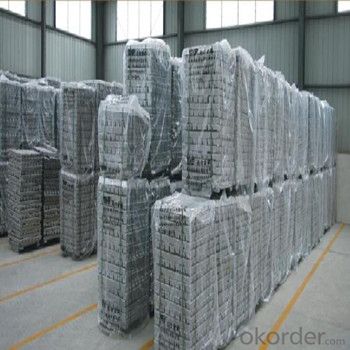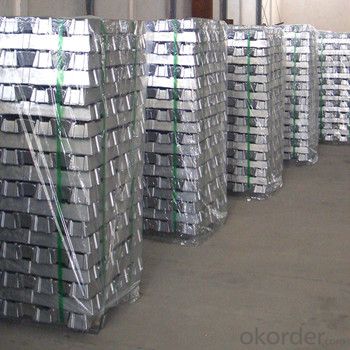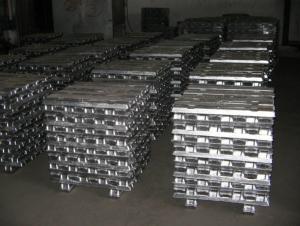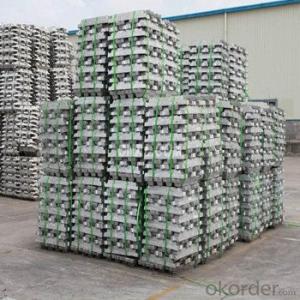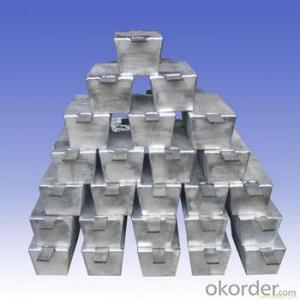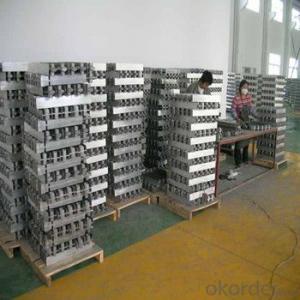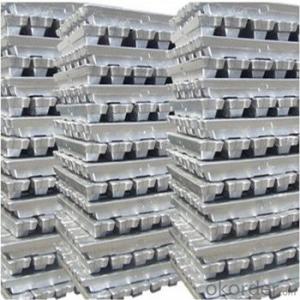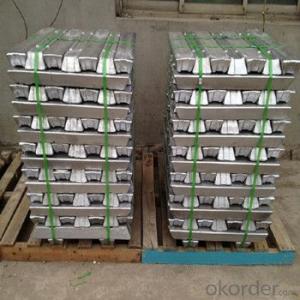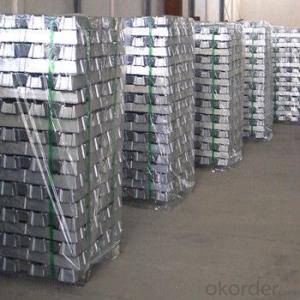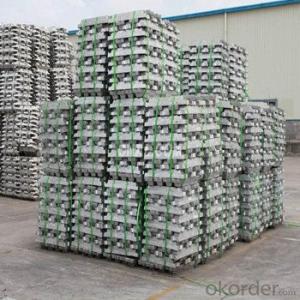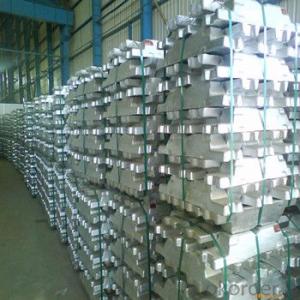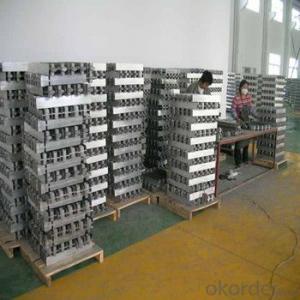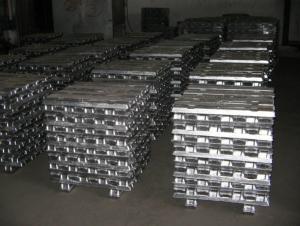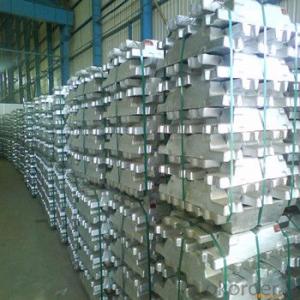Aluminum Pig/Ingot Sold By Chinese Manufacturers Directly
- Loading Port:
- China main port
- Payment Terms:
- TT OR LC
- Min Order Qty:
- 1000 m.t.
- Supply Capability:
- 100000 m.t./month
OKorder Service Pledge
OKorder Financial Service
You Might Also Like
Pure Aluminum Pig/Ingot Used for Industry
1.Structure of Aluminum Pig/Ingot
A material that has been cast into a shape in order to be transported and processed easier than in an unprocessed form. An ingot is typically rectangular in shape, which allows it to be stacked. Ingots are most commonly associated with metals, with ingots of gold held in the vaults of banks and brokerages being popular images.
Aluminum Ingot is with the AL as the main chemical composition.Aluminum Ingot is used for industry,such as automobile,pinning and weaving,electron broadly and so on. Aluminum Ingot has the following advantages: easy control and operation, fast melting.
2.Main Features of the Aluminum Pig/Ingot
•High Purity
•Easy control and operation
•High strength
•Fast melting
•Competitive price
•Best Service
3.Aluminum Pig/Ingot Images
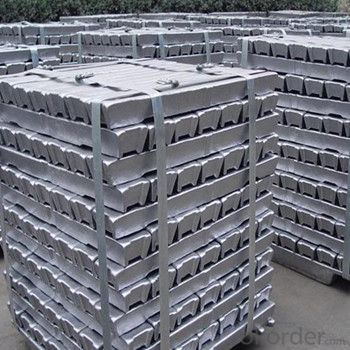

4.Aluminum Pig/Ingot Specification
Grade | Chemical Composition % | |||||||||
Al≥ | impurities ≤ | |||||||||
Si | Fe | Cu | Ga | Mg | Zn | Mn | others | Sum | ||
Al99.9 | 99.90 | 0.50 | 0.07 | 0.005 | 0.02 | 0.01 | 0.025 | - | 0.010 | 0.10 |
Al99.85 | 99.85 | 0.80 | 0.12 | 0.005 | 0.03 | 0.02 | 0.030 | - | 0.015 | 0.15 |
Al99.7 | 99.70 | 0.10 | 0.20 | 0.010 | 0.03 | 0.02 | 0.030 | - | 0.030 | 0.30 |
Al99.6 | 99.60 | 0.16 | 0.25 | 0.010 | 0.03 | 0.03 | 0.030 | - | 0.030 | 0.40 |
Al99.5 | 99.50 | 0.22 | 0.30 | 0.020 | 0.03 | 0.05 | 0.050 | - | 0.030 | 0.50 |
Al99.00 | 99.00 | 0.42 | 0.50 | 0.020 | 0.03 | 0.05 | 0.050 | - | 0.050 | 1.00 |
5.FAQ of Aluminum Pig/Ingot
We have organized several common questions for our clients,may help you sincerely:
①How about your company?
A professional factory which foucs on producing the aluminum pig,can meet customers' requiement to the quality and grade.The quality also have been accepted by customer.Already got the good reputation among the customers.It have gotten lot of much experience.The facrtory has the professional Technical Worker and the advanced equipments for production.Beside,it has the profesional teams to operate the whole proess for exporting.OEM service is availble and welcome.The items have beedn exported around the world,and have been acceptable among the customers,and have gotten the good reputation already.No matter from the quality,price and service,can be guaranteed for the cusgtomers.High purity and diffent grade are available.
②How to guarantee the quality of the products?
We have established the international advanced quality management system,every link from raw material to final product we have strict quality test;We resolutely put an end to unqualified products flowing into the market. At the same time, we will provide necessary follow-up service assurance.
③How long can we receive the prod rking days, We will arrange the factory delivery as soon as possible. The pecific time of receiving is related to the state and position of customers.Commonly 7 to 10 working days can be served.
- Q: Can aluminum ingots corrode?
- Indeed, it is possible for aluminum ingots to experience corrosion. Despite being renowned for its resistance to corrosion, aluminum is not entirely impervious to it. When subjected to specific environments, like those containing high salt or acid concentrations, aluminum can undergo a process known as oxidation. This process gives rise to the formation of a thin layer of aluminum oxide on the surface of the metal, which serves as a safeguard, preventing further corrosion. Nonetheless, if this protective layer becomes damaged or compromised, the underlying aluminum can become vulnerable to corrosive elements, ultimately resulting in corrosion. Consequently, although aluminum ingots generally display resistance to corrosion, it is crucial to exercise proper caution and take necessary measures to shield them in corrosive surroundings.
- Q: What are the different grades of aluminum ingots?
- There are several different grades of aluminum ingots, each with specific properties and uses. The most commonly recognized grades include: 1. Pure Aluminum (99%+): This grade is the most basic form of aluminum and is highly malleable, lightweight, and corrosion-resistant. It is often used in applications where high electrical conductivity is required, such as electrical wiring and transmission lines. 2. Aluminum Alloys: These grades are composed of aluminum combined with other elements, such as copper, magnesium, silicon, or zinc, to enhance specific properties. For example, aluminum alloys with copper are known for their excellent strength and corrosion resistance, making them ideal for structural components in aerospace or automotive industries. 3. Cast Aluminum: This grade is produced by the casting process and is typically used for manufacturing engine parts, automotive wheels, and other heavy-duty applications where strength and durability are crucial. 4. Wrought Aluminum: Wrought aluminum ingots undergo a shaping process, such as rolling or extrusion, to create specific forms like sheets, plates, or bars. This grade is commonly used in the construction industry for structural elements like beams, columns, and facade systems. 5. High-Strength Aluminum: These grades are engineered to have superior strength while maintaining good formability. They are often employed in industries where lightweight, yet sturdy materials are required, such as aerospace, military, or sporting goods manufacturing. It's important to note that these grades can further be categorized into specific alloys, each with its own unique characteristics and applications. The choice of aluminum grade depends on the intended use, desired properties, and manufacturing requirements of the final product.
- Q: How much is each ton of aluminium ingot and stainless steel ingot?
- The malleability of gold is very strong and, to put it simply, is very soft! There should be a slight print of the bite! That's why ancient people like to bite gold!
- Q: What is the process for smelting aluminum ingots?
- Smelting aluminum ingots consists of several steps. To start, bauxite ore, which serves as the main aluminum source, is mined and refined to extract impurities. The refined bauxite is then converted into alumina using the Bayer process. Following that, a large electric furnace is utilized to combine the alumina with cryolite and other additives. This mixture is subjected to extremely high temperatures, reaching approximately 1,800 degrees Celsius. The intense heat causes the alumina to melt and separate into aluminum and oxygen. Subsequently, the molten aluminum is tapped from the furnace and transferred to either a holding furnace or a ladle. During this stage, it is common to alloy the aluminum with other metals to enhance its properties. Common alloying elements include magnesium, silicon, copper, and zinc. Once the desired alloy composition is attained, the molten aluminum is poured into molds to create ingots. These molds are typically constructed from steel and can vary in size and shape based on specific requirements. After the aluminum has solidified and cooled, the ingots are extracted from the molds and undergo further processes such as heat treatment or rolling to achieve the desired mechanical properties and shape. In summary, the smelting process of aluminum ingots encompasses mining and refining bauxite, converting it into alumina, melting the alumina to separate aluminum and oxygen, alloying the molten aluminum, pouring it into molds, and finally processing the solidified ingots to achieve the desired properties.
- Q: What are the different machining techniques for aluminum ingots?
- There are several different machining techniques that can be used for aluminum ingots. Some of the most common techniques include: 1. Turning: Turning is a machining process where a cutting tool is used to remove material from the surface of the aluminum ingot to create a desired shape or size. This technique is often used to create cylindrical parts such as rods or shafts. 2. Milling: Milling involves using a rotating cutting tool to remove material from the surface of the aluminum ingot. This technique can be used to create a variety of shapes and features, including slots, pockets, and complex contours. 3. Drilling: Drilling is a machining technique that involves creating holes in the aluminum ingot using a rotating cutting tool. This technique can be used to create holes of various sizes and depths. 4. Grinding: Grinding is a machining process where an abrasive wheel is used to remove material from the surface of the aluminum ingot. This technique is often used to achieve a smooth and precise surface finish. 5. Boring: Boring is a machining process that involves enlarging an existing hole in the aluminum ingot using a single-point cutting tool. This technique is often used to create larger diameter holes. 6. Sawing: Sawing is a machining technique where a saw blade is used to cut the aluminum ingot into desired lengths or shapes. This technique is commonly used for cutting aluminum ingots into smaller pieces for further processing. 7. Lathing: Lathing is a machining technique that involves rotating the aluminum ingot while a cutting tool is used to remove material from its surface. This technique is often used to create symmetrical parts such as cones or spheres. These are just a few of the many machining techniques that can be used for aluminum ingots. The choice of technique depends on the desired shape, size, and surface finish of the final product.
- Q: What are the different extrusion processes for aluminum ingots?
- There are several different extrusion processes for aluminum ingots, including direct extrusion, indirect extrusion, and hydrostatic extrusion. In direct extrusion, the aluminum ingot is forced through a die using a ram. Indirect extrusion involves placing the ingot in a hollow container and applying pressure to force it through a die. Hydrostatic extrusion uses a fluid to apply pressure to the ingot, pushing it through a die. Each of these processes has its own advantages and is used depending on the specific requirements of the product being manufactured.
- Q: Sincerely ask predecessors to tell me about the processing of aluminum ingots to doors and windows, curtain walls, aluminum profiles, the general process and about the process!
- The first cast aluminum rod, generally with the same level hot top casting equipment, casting equipment Woge Gustave America more now.
- Q: What does aluminium ingot blacken because of temperature? Rain? Aluminium oxide? Iron salt?
- The humidity is contacted with the air and is oxidized. The aluminum ingot also contains trace amounts of other metal elements, which are also oxidized to black
- Q: What is the average price of an aluminum ingot?
- The average price of an aluminum ingot can vary depending on various factors such as market conditions, supply and demand dynamics, and regional factors. As of [current date], the average price of an aluminum ingot is approximately [average price]. However, it is important to note that this price is subject to change and it is advisable to consult with industry sources or market experts for the most up-to-date and accurate pricing information.
- Q: What are the health risks associated with working with aluminum ingots?
- The health risks associated with working with aluminum ingots include inhalation of aluminum particles or fumes, which can lead to respiratory issues such as coughing, shortness of breath, and lung damage. Prolonged exposure may also increase the risk of developing lung diseases like asthma or bronchitis. Additionally, handling aluminum ingots without proper protective equipment may result in skin irritation or allergic reactions. It is crucial to follow safety guidelines and use appropriate personal protective equipment to minimize these risks.
Send your message to us
Aluminum Pig/Ingot Sold By Chinese Manufacturers Directly
- Loading Port:
- China main port
- Payment Terms:
- TT OR LC
- Min Order Qty:
- 1000 m.t.
- Supply Capability:
- 100000 m.t./month
OKorder Service Pledge
OKorder Financial Service
Similar products
Hot products
Hot Searches




